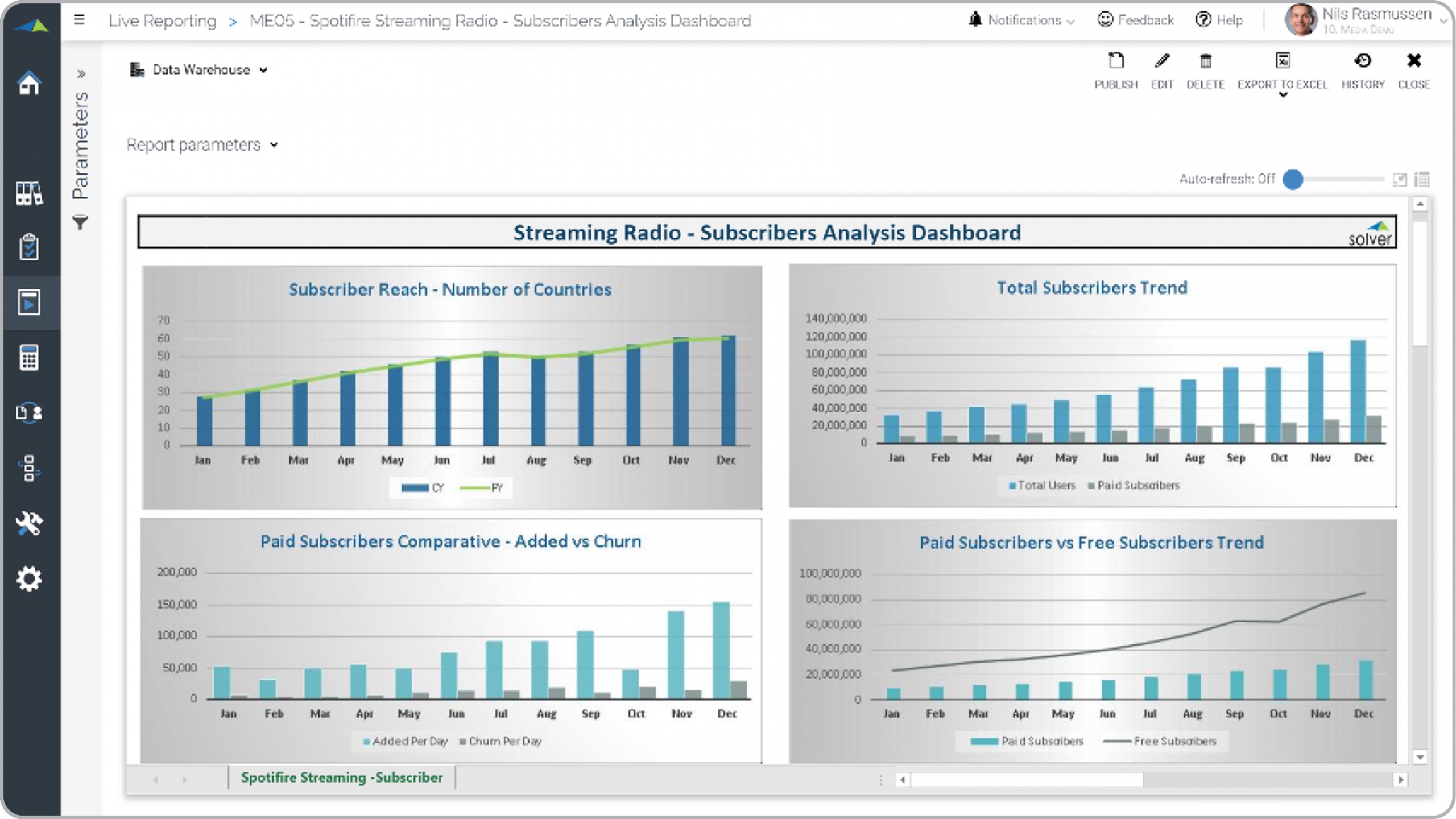Streaming Radio Subscriber Dashboard for Media Companies
What is
a
Subscriber Dashboard
? Subscriber Dashboards are considered statistical analysis tools and are used by streaming radio media executives to analyze monthly trends in subscriber metrics. Some of the main functionality in this type of dashboard is that it shows monthly trends for six different KPIs, including: 1) Current year (CY) and prior year (PY) subscriber reach by number of countries, 2) Comparison of number of added and churned subscribers per day, 3) Total users versus paid subscribers, and 4) Paid subscribers versus free subscribers. You find an example of this type of dashboard below.
Purpose of
Subscriber Analysis Dashboards for Streaming Radio Media companies use Subscriber Analysis Dashboards for Streaming Radio to provide a self-service tool to closely monitor monthly trends in the most essential subscriber metrics. When used as part of good business practices in Subscriber Sales and Media departments, a company can improve its marketing and product strategies, and it can reduce the chances that subscriptions underperform due to lack of timely and informed management decisions.
Example of a
Subscriber Dashboard for Streaming Radi
o Here is an example of a Subscriber Analysis Dashboard with streaming radio metrics and monthly trends. [caption id="" align="alignnone" width="2560"]
 Example of a Subscriber Dashboard for streaming radio media companies[/caption] You can find hundreds of additional examples
here
Who Uses This Type of
Dashboard
? The typical users of this type of dashboard are: Executives, Content Managers, Marketing Managers, Category Managers, Budget Managers.
Other Reports Often Used in Conjunction with
Subscriber Dashboards for Streaming Radio Progressive Subscriber Sales and Media departments sometimes use several different Subscriber Dashboards, along with recurring revenue forecasts, recurring revenue dashboards, churn reports, subscription reports, sales forecasts, profit & loss reports, annual budgets, financial dashboards, KPI dashboards and other management and control tools.
Where Does the Data for Analysis Originate From? The Actual (historical transactions) data typically comes from enterprise resource planning (ERP) systems like: Microsoft Dynamics 365 (D365) Finance, Microsoft Dynamics 365 Business Central (D365 BC), Microsoft Dynamics AX, Microsoft Dynamics NAV, Microsoft Dynamics GP, Microsoft Dynamics SL, Sage Intacct, Sage 100, Sage 300, Sage 500, Sage X3, SAP Business One, SAP ByDesign, Acumatica, Netsuite and others. In analyses where budgets or forecasts are used, the planning data most often originates from in-house Excel spreadsheet models or from professional corporate performance management (CPM/EPM) solutions.
What Tools are Typically used for Reporting, Planning and Dashboards? Examples of business software used with the data and ERPs mentioned above are:
Example of a Subscriber Dashboard for streaming radio media companies[/caption] You can find hundreds of additional examples
here
Who Uses This Type of
Dashboard
? The typical users of this type of dashboard are: Executives, Content Managers, Marketing Managers, Category Managers, Budget Managers.
Other Reports Often Used in Conjunction with
Subscriber Dashboards for Streaming Radio Progressive Subscriber Sales and Media departments sometimes use several different Subscriber Dashboards, along with recurring revenue forecasts, recurring revenue dashboards, churn reports, subscription reports, sales forecasts, profit & loss reports, annual budgets, financial dashboards, KPI dashboards and other management and control tools.
Where Does the Data for Analysis Originate From? The Actual (historical transactions) data typically comes from enterprise resource planning (ERP) systems like: Microsoft Dynamics 365 (D365) Finance, Microsoft Dynamics 365 Business Central (D365 BC), Microsoft Dynamics AX, Microsoft Dynamics NAV, Microsoft Dynamics GP, Microsoft Dynamics SL, Sage Intacct, Sage 100, Sage 300, Sage 500, Sage X3, SAP Business One, SAP ByDesign, Acumatica, Netsuite and others. In analyses where budgets or forecasts are used, the planning data most often originates from in-house Excel spreadsheet models or from professional corporate performance management (CPM/EPM) solutions.
What Tools are Typically used for Reporting, Planning and Dashboards? Examples of business software used with the data and ERPs mentioned above are:
- Native ERP report writers and query tools
- Spreadsheets (for example Microsoft Excel)
- Corporate Performance Management (CPM) tools (for example Solver)
- Dashboards (for example Microsoft Power BI and Tableau)
Corporate Performance Management (CPM) Cloud Solutions and More Examples
July 26, 2021
TAGS:
Reporting,
Solver,
print,
report writer,
Microsoft,
template,
practice,
Acumatica,
Netsuite,
TV,
streaming,
Finance,
planning,
GP,
Business Central,
excel,
radio,
ax,
forecast,
Budget,
Dynamics 365,
budgeting,
Cloud,
Software,
Tableau,
SAP,
example,
media,
best,
Sage,
BC,
D365,
NAV,
Intacct,
broadcast,
online,
CPM,
report,
SL,
Management,
dynamics,
Power BI,
media dashboard,
churn,
subscriber reach,
streaming analysis,
streaming radio,
subscribers,
paid subscribers

